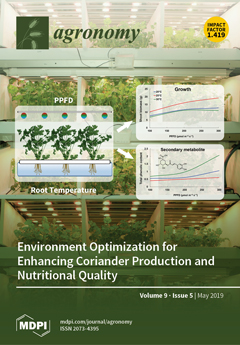The emerging role of plant biostimulants in enhancing nutrient efficiency is important for maintaining soil fertility under sub-optimal nutrient regimens. We aimed to elucidate the morpho-physiological and biochemical effects as well as mineral composition changes of greenhouse jute (
Corchorus olitorius L.) treated with a commercial vegetal-derived biostimulant from a tropical plant extract (PE; Auxym
®, Italpollina, Rivoli Veronese, Italy). Plants were sprayed in weekly intervals with a solution containing 2 mL·L
−1 PE. Jute plants were supplied with three nutrient solution concentrations: full-, half-, and quarter-strength. Decreasing macronutrient concentrations in the nutrient solution (NS), especially at quarter-strength, triggered a decrease in several morphological (plant height, leaf number, and dry biomass) and physiological (net CO
2 assimilation rate (A
CO2) and SPAD (Soil Plant Analysis Development) index) parameters. PE application triggered specific ameliorative effects in terms of fresh yield at both half- and quarter-strength nutrient solution (15.5% and 29.5%, respectively). This was associated with an enhancement in A
CO2, SPAD index, and especially the nutritional status (high nitrate, K, and Mg contents, and low Na content). The foliar application of PE, strongly increased chlorophyll b content, enhancing jute plant adaptation to fluctuating light and therefore the efficiency of photosynthesis, positively affecting starch, soluble proteins, and total amino acids content but only when jute plants were irrigated with full-strength NS, compared to the respective control treatment. At lower nutrient strength, PE reprogrammed the nitrogen distribution, allowing its remobilization from glutamate, which was quantitatively the major amino acid under lower nutrient strength, but not from chlorophylls, thus maintaining efficient photosynthesis. We confirmed that PE Auxym
® acts in a balanced manner on the main metabolic pathways of the plant, regulating the uptake and transport of mineral nutrients and protein synthesis, increasing the accumulation of essential amino acids under full nutritive solutions, and re-distributing nitrogen from amino acids to allow leaf growth and expansion even under sub-optimal nutrient conditions. Overall, the use of natural plant biostimulants may be a potential solution in low-input conditions, where environmental constraints and restricted use of fertilizers may affect potential crop productivity.
Full article





